
Osteochondrosis is a kind of degenerative dystrophic intervertebral disc disease. The cervical spine is the most vulnerable part of the spine, which has very close adjacent vertebrae and weak muscle waists, which are anatomically different structures. Therefore, even if the neck bears a small additional load, the vertebrae will shift, resulting in compression of blood vessels and nerves.
Moreover, since the vertebral artery involved in blood supply to the brain passes through the hole in the transverse process of the vertebrae, clamping the vertebrae in this section or being squeezed by the overgrown osteophytes will bring very serious consequences.
what is this?
Cervical osteochondrosis is a progressive disease with multiple causes, manifested by degeneration of the intervertebral disc and malnutrition of the spinal ligament tissue.
cause
The main causes and premises of cervical osteochondrosis are:
- Curved spine, scoliosis.
- Stress and nervousness will have a negative impact on the general health of the body and cause cervical osteochondrosis.
- Delayed infectious diseases often become the root cause.
- Incorrect, uncomfortable body posture during sleep (for example, uncomfortable pillows).
- The presence of congenital problems or hereditary diseases of the cervical spine.
- Poor posture in youth and adolescence.
- Overweight and obesity of varying degrees. The extra weight increases the load on the vertebrae and intervertebral discs, which leads to the degenerative process.
- Back injuries that may occur in childhood or adolescence.
- Interruption of the metabolic process.
- Work related to physical labor can cause diseases in various parts of the spine.
- Inactive lifestyle, sedentary work, improper performance of any exercise.
To successfully treat cervical osteochondrosis, we must first clarify the cause, the prerequisites that induce its development, and eliminate it. Until recently, this disease only occurred in people over 45 years of age. Now young people are exposed to it, the age range is 18-25 years old.
Features of cervical spondylosis
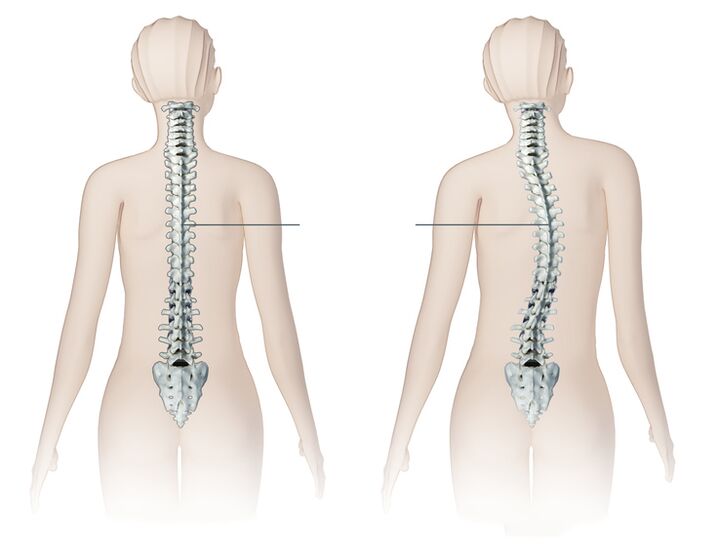
Consider how the neck area is different from other parts of the spine, and the development of osteochondrosis is a prerequisite for the development of these syndromes.
- In the neck area, there are important ganglia (nodes) of the autonomic nervous system.
- In the transverse process of the vertebrae, a hole forms the spinal canal. The vertebral artery passes through the spinal canal to provide oxygen and nutrients to the brain, cerebellum, auditory organs, and spinal nerves. These are the prerequisites for frequent arterial and nerve clamps.
- The cervical spine is the most flexible. He is characterized by a comprehensive range of sports of all types. These are the prerequisites for frequent infringement and subluxation!
- The foramen of the lower three vertebrae are not round, but triangular. These are the prerequisites for the invasion of nerve roots by bone growth formed in osteochondrosis.
- The intervertebral disc is not located between the vertebral bodies along its entire length. In the front, they are replaced by the protruding edges of the vertebrae, which are connected to each other by joints.
The following are the key features that we will analyze the symptoms and complications of osteochondrosis on this basis.
progression stage
The degree of osteochondrosis depends on the clinical manifestations and the main complaint of the patient. The concept of degree should not be confused with the stage of osteochondrosis. These stages will be discussed below.
- The first level. The clinical manifestations are mild, and patients may complain of low-intensity pain in the cervical spine, which worsens when turning the head. Physical examination may show slight tension in the neck muscles.
- The second degree. The patient is worried about the pain of the cervical spine, which is much stronger, and the pain may radiate to the shoulders and arms. Pain increases when tilting and turning the head. Patients may notice decreased performance, weakness, and headaches.
- Three degrees. The symptoms of cervical osteochondrosis will worsen, and the pain will continue when the arm or shoulder is irradiated. As a herniated disc develops, the arm muscles will become numb or weak (see Symptoms of Lumbar Disc Herniation). The examination showed that the cervical spine was limited in motion and the cervical spine was painful on palpation.
- Level four. The intervertebral disc is completely destroyed and replaced by connective tissue. Dizziness worsens, tinnitus appears, and coordination is impaired.
symptom
The severity of the symptoms of cervical osteochondrosis depends on the degree of destruction of the vertebral structure. With the formation of osteophytes, bone tissue growth, nerve root syndrome (nerve root pain when nerves are compressed), and intervertebral disc herniation (the disc herniated into the spinal canal), the symptoms will aggravate.
The first signs of the disease are periodic headaches in the back occiput, neck soreness, squeaking and clicking noises from the vertebrae when turning the head, and sometimes a slight tingling sensation in the shoulders. Over time, the symptoms will increase and the intensity of the pain will increase.
Pain syndrome is the main manifestation of osteochondrosis. When turning the head, neck pain may be dull, persistent, or severe, accompanied by low back pain under the occiput. The entire cervical spine area or the projection area of the modified vertebrae, as well as the clavicle, shoulder, scapula, and heart area may be injured. Restriction of head movement due to pain usually occurs in the morning after sleeping in an uncomfortable position.
This disease causes compression of the peripheral nerve roots (root syndrome) and causes pain in the course of these nerves. It may be numbness of the hands or fingers, and impaired sensitivity in certain areas of the skin innervated by the squeezing nerve.
Based on some characteristic symptoms, one can assume which vertebrae are affected:
- C1-Violation of the sensitivity of the occipital region;
- C2-Pain in the area of the occiput and parietal lobe;
- C3-Decreased sensitivity and pain in the half of the neck where spinal nerves are invaded, which may be due to impaired sensitivity of the tongue, and language disorders due to loss of control of the tongue
- C4-Impaired sensitivity and pain in the scapular area, decreased head and neck muscle tone, possible breathing disorders, liver and heart pain;
- C5-Pain and impaired sensitivity on the outer surface of the shoulder;
- C6-Pain extending from the neck to the scapula, forearm, outer surface of the shoulder, radial surface of the forearm to the thumb;
- C7-Pain spreads from the neck to the scapula, the back of the shoulder, the forearm to the II-IV finger of the hand, and the sensitivity of this area is impaired.
- C8-Pain and sensory disturbances spread from the neck to the shoulders, and from the forearms to the little fingers.
The rattling or crunching during neck exercises was observed in every patient almost always accompanied by cervical osteochondrosis. Crunch occurs when the head is turned sharply or thrown back.
Syndrome caused by cervical osteochondrosis
The symptoms of cervical osteochondrosis are grouped together, called syndromes. Their presence and severity may indicate a specific location of cervical spine disease.
A set of common syndromes:
- Vegetative dystonia syndrome. Subluxation and displacement of the first cervical vertebra can lead to the development of vegetative vascular dystonia. VSD is not a definite diagnosis because it has no obvious symptoms. There may be signs of the nervous system, symptoms of impaired cerebral blood flow, increased intracranial pressure, and muscle spasms. As a result, the patient's main complaints were reduced to dizziness, decreased vision, loss of consciousness, headache, and nausea.
- Irritating and reflexive. Burning and severe pain at the back of the head and neck, sometimes returning to the chest and shoulders, appearing when the head and neck position changes, sneezing and head turning sharply.
- extreme. Also known as cervical radiculitis, it combines symptoms related to cervical nerve root invasion. It is characterized by "chills" in the affected area. Fingers and forearms are tingling, and the skin is mushy, spreading to some fingers.
- heart. Pictures almost identical to angina pectoris often lead to incorrect diagnosis and treatment. The syndrome occurs because the receptors of the phrenic nerve are stimulated, partially trapping the pericardium and pectoralis major muscle. Therefore, the spasm in the heart area is more reflexive, like a response to cervical nerve stimulation.
- Vertebral artery syndrome. It develops directly with the compression of the artery itself and the stimulation of the sympathetic nerve plexus located around it. This pathological pain is burning or throbbing in the occipital area and spreads to the temples, brow arches, and crowns. Occurs on one side and both sides. Patients usually get worse after sleeping in non-physiological positions, taking transportation, or walking. When the symptoms are severe, hearing loss, dizziness, tinnitus, nausea, vomiting, loss of consciousness, and increased blood pressure may occur.
The non-specificity and a large number of various symptoms that accompany this disease complicate diagnosis and further treatment, as some of them may be signs of completely different diseases.
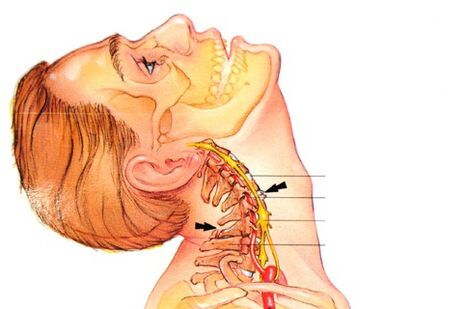
diagnosis
Like any diagnosis in medicine, the diagnosis of osteochondrosis is based on the patient's chief complaint, medical history, clinical examination and auxiliary research methods. If necessary, cervical radiographs can be performed in frontal and lateral projections in a special position (open mouth). At the same time, experts are interested in the height of the intervertebral disc and the presence of osteophytes.
In modern research methods, MRI and CT studies are used, which can most accurately verify the diagnosis. In addition to the additional research methods listed, you may also need to consult relevant experts (cardiologists, ophthalmologists, neurosurgeons). The neurologist’s examination is essential. The neurologist is engaged in the treatment of osteochondrosis, so after examining the patient, he will decide on his own to perform the minimum necessary examinations.
How to treat cervical osteochondrosis?
The comprehensive treatment of cervical osteochondrosis can include the following traditional and non-traditional methods: medication, massage, acupressure, manual therapy, physical therapy, acupuncture, homeopathy, folk remedies, etc.
The main treatment plan for osteochondrosis is the same for all parts of the disease:
- First of all you need to relieve the pain.
- Then the swelling will be removed.
- At this stage, blood circulation needs to be normalized.
- A corset to strengthen muscles.
- Improve nutrition and tissue regeneration.
The list of drugs and drugs used to treat cervical osteochondrosis in China is very extensive:
- Anti-inflammatory (steroids). These hormone drugs can relieve inflammation, thereby eliminating pain. In most cases, for cervical osteochondrosis, tablets and ointments based on hydrocortisone, prednisolone or dexamethasone are used;
- Analgesics (non-steroidal analgesics). They are usually prescribed as tablets or capsules. It should be remembered that most of these drugs irritate the lining of the digestive tract. In modern medicine used to relieve pain in osteochondrosis;
- Muscle relaxants are drugs that relax muscle tension. They are used in surgery and plastic surgery as an aid to relieve pain. These drugs are administered parenterally, so they are always under the supervision of a doctor. There are a large number of contraindications;
- A chondroprotective agent is a preparation containing chondroitin and hyaluronic acid, which replace cartilage components. In order to obtain long-lasting positive effects, such drugs must be taken for a long time;
- Topical ointments and gels. This is the group of drugs that are easiest to use at home. They are divided into anti-inflammatory drugs, warming drugs and analgesics. Such funds are often advertised. For cervical osteochondrosis, not all ointments are effective. In addition, due to their availability, they are sometimes used unreasonably and the specificity of the pathogenesis is not considered.
- Vitamins. For osteochondrosis, vitamins are prescribed, which have a beneficial effect on the peripheral nervous system and increase electrical conductivity. Water-soluble vitamins: B1, B6, B12, fat-soluble vitamins: A, C, D, E. In recent years, it has become more and more common to prescribe compound preparations containing painkillers and vitamins. An effective preparation includes B vitamins based on pyridoxine and thiamine, and an anesthetic.
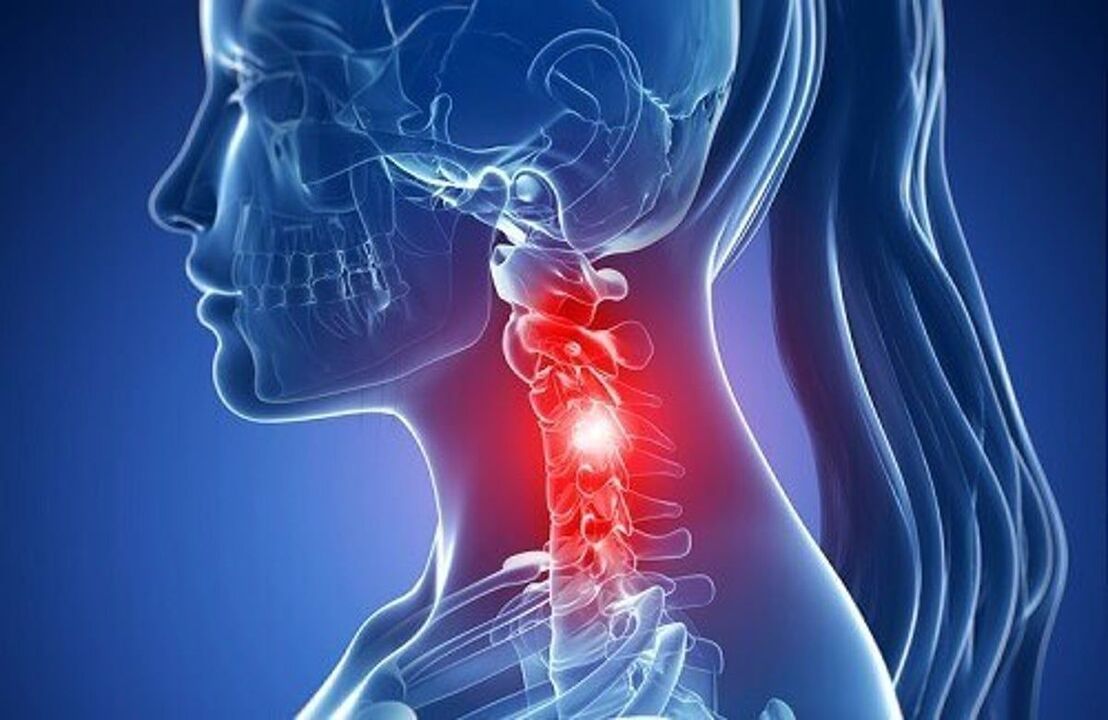
Only an excellent team of experts can choose the most appropriate therapy, including neurologists, physical therapists, massage therapists, surgeons, and spinal neurologists.
physiotherapy
Exercise therapy for cervical osteochondrosis should be performed outside the acute exacerbation period. The maximum efficiency of this technique is during the recovery period. There should be no discomfort and pain during the complex process!
- Exercise #1 Lie on your stomach, put your hands on the floor, raise your head and torso, and your back should be straight. Maintain this position for 1-2 minutes. Slowly lower yourself to the floor. Repeat 2-3 times.
- Exercise 2 Lie on your stomach, extend your arms along your body, turn your head to the left, try to touch the floor with your ears, and then turn your head to the right. Repeat 6-7 times in each direction.
- Exercise 3 In a sitting position, when you inhale, bend forward and try to touch your chest with your head, then exhale, bend back and tilt your head back. Repeat 10-15 times.
- Exercise #4 Sit, place your palms on your forehead, press your palms on your forehead, and place your forehead on your palms. Continue this exercise for 30 seconds. Repeat 2-3 times.
- Exercise 5 Slowly rotate your head in one direction first, and then in the other direction. Rotate 10 times in each direction. Pay attention to dizziness. When it appears, the practice stops.
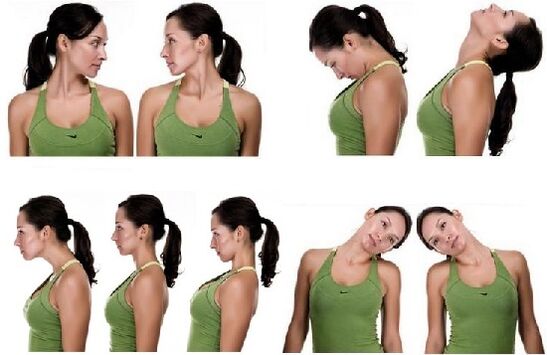
Massage therapy
Massage can be done at home, but be very careful not to aggravate and harm the patient. The patient should adopt a lying position, place the forehead on the hand, and extend the chin toward the chest. In this case, the neck muscles should be completely relaxed.
- Stroking. It is necessary to start the massage with these movements: stroke the collar from the lymph to the supraclavicular and axillary lymph nodes. Then apply flat and comb strokes.
- push ups. To perform push-ups, the masseur places one hand on the neck (the index finger and thumb should be placed together) and moves it down the spine. You can also perform push-ups from the edge of the palm to the shoulder joint.
- grinding. The friction is to warm up the muscles, relax them, and improve blood flow to the area. The massage should start at the base of the skull, using the fingers to make circular and straight movements. You can also use the palm parallel to the ribs for sawing motion.
- Kneading. Knead the neck in circular motions.
- vibration. The massage ends with percussion and vibration, which is carried out with the help of shaking and percussion.

Massage is necessary to strengthen muscle tone and relieve pain. According to the stage of osteochondrosis, the massage technique is selected. However, when performing neck massage, experts use all classic massage techniques: rubbing, stroking, kneading, etc. If the patient has pain in only one neck area, the massage starts from the healthy part of the neck and gradually moves to the collar area where the pain is strong.
Manual therapy
Manual therapy helps to cope with acute and chronic pain. It can also increase the range of motion and improve posture well. The main methods of treatment of cervical osteochondrosis:
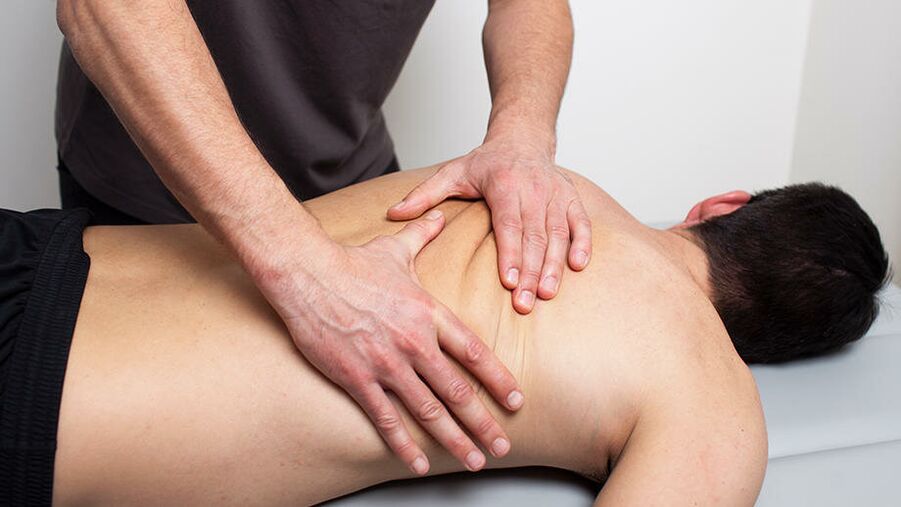
- Relaxing and segmented massage. It is used to warm up muscles and relieve tension.
- mobilization. Designed to restore the effect of joint function. Through the stretching method.
- manipulate. A violent push for the patient's pathological area. This process is accompanied by a characteristic tightening (the joint returns to its normal position).
Experts who practice manual therapy should be proficient in these techniques. Otherwise, any error may cause injury.
Orthopedic Pillow
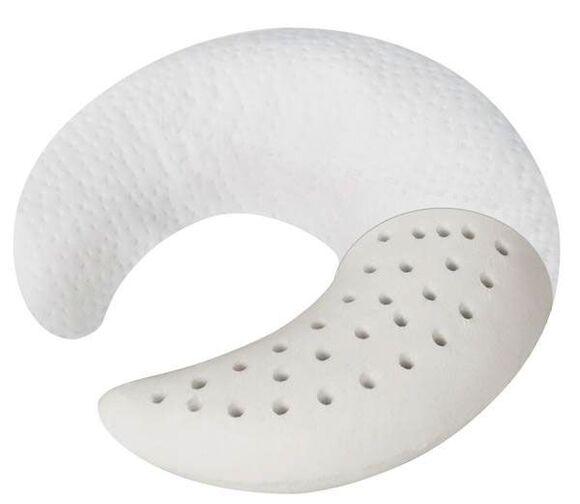
Orthopedic sleeping pillows are an effective preventive measure. In many cases, when sleeping on an uncomfortable pillow, additional compression of the carotid arteries and nerve roots can exacerbate osteochondrosis. The orthopedic product can ensure that people maintain a consistent horizontal position during sleep, thereby ensuring a physiologically sufficient blood supply to the brain.
When choosing a pillow, one’s individual anatomical characteristics should be considered and correlated with the volume and characteristics of the filling. The correct choice of pillows can bring tangible benefits to patients with cervical osteochondrosis.
physiotherapy
Physical therapy procedures for cervical osteochondrosis:
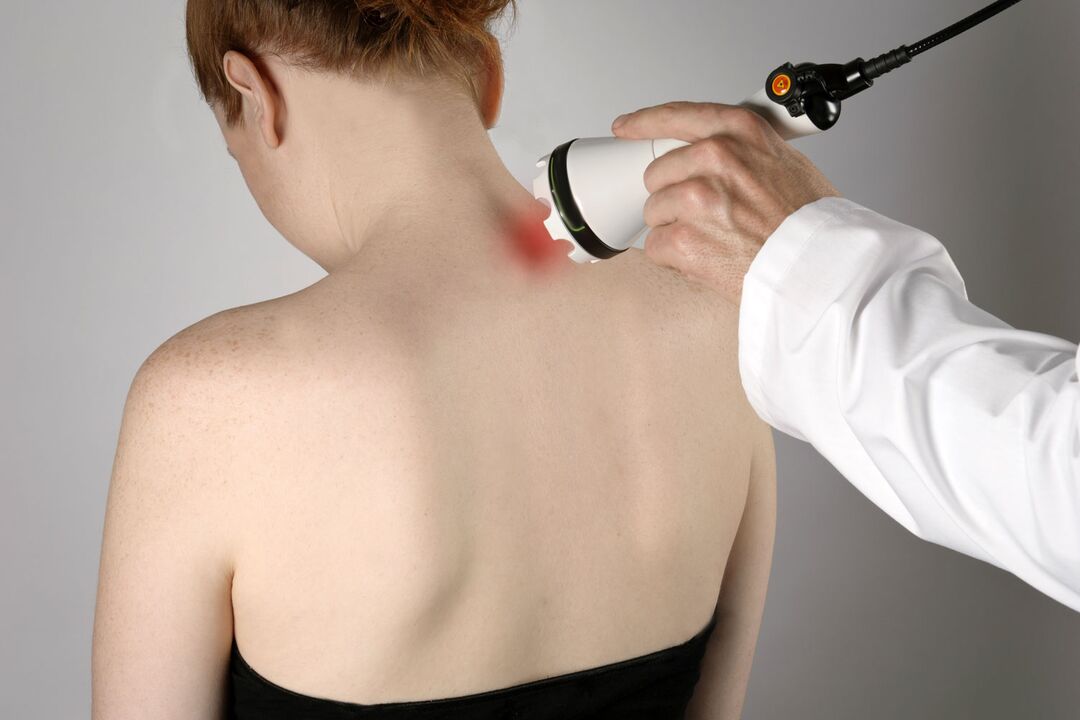
- Electrophoresis. Should be used together with analgesics (narcotics), which are injected under the skin with electronic pulses
- Ultrasound. It has a beneficial effect on the metabolic process of cervical spine tissue, so the edema is eliminated and the pain disappears.
- Magnetic therapy. A safe treatment method involves exposing damaged cells to a low-frequency magnetic field. It has analgesic effect and acts as an anti-inflammatory agent
- Laser Treatment. Improve blood circulation in the affected area, relieve tissue swelling and pain.
Physical therapy procedures have beneficial effects on the discs and vertebrae of cervical osteochondrosis. Combined with taking medications, combined treatments help get rid of the symptoms of the disease. These procedures are carried out in specialized offices of hospitals or polyclinics. Before starting the course, you must consult a doctor to determine the duration and type of physical therapy. It is strictly prohibited to pass it during the deterioration period.
Single collar
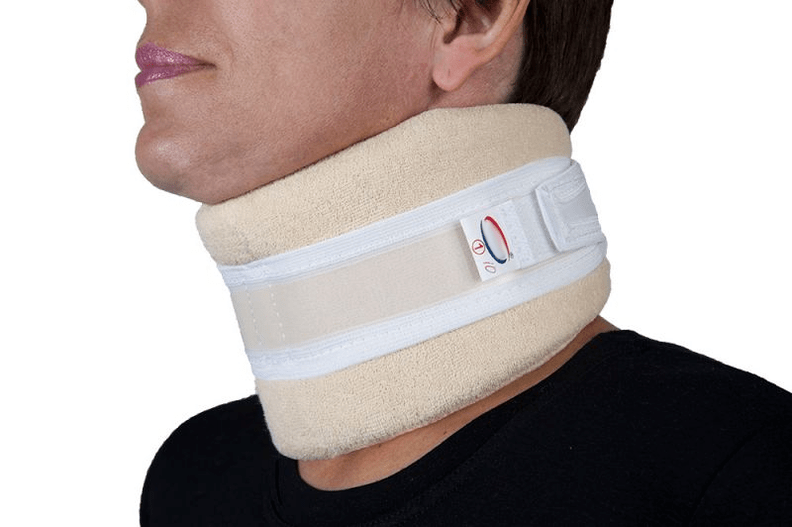
Shants collar is a soft and comfortable device, the back is fixed with Velcro, used for cervical osteochondrosis. But not for treatment, but to temporarily relax and relieve fatigue. You cannot wear it without taking it off, otherwise the neck muscles will stop working and will soon atrophy. If the collar of Shants is selected correctly, the patient will feel comfortable and protected.
The collar is selected strictly according to the size of the pharmacy or orthopedic shop. It's better to be in the store, because the people working there are usually very knowledgeable about the characteristics of their business and products, which means they can help in each specific situation.
Folk remedies
If the pain caused by osteochondrosis of the spine becomes unbearable and regular, then you will agree to take any measures to stop it, where traditional complex treatments will be successfully supplemented by alternative methods.
- Stick to celery root (5 grams per 1 liter of boiling water) for 4 hours, and drink one tablespoon before each meal;
- Compressed honey, for this we take 2 teaspoons. Honey and 1 piece of mummy. We heat the components in a water bath, spread them on a cloth and apply them to the neck area, which is the neck, at night;
- In the case of acute pain, horseradish grown in the country helps me. I just wash his leaves, pour them with boiling water, cool them a bit, apply them on my neck, and wrap them in a thin scarf overnight-you can already live and work in the morning;
- We insist on soaking chamomile flowers in vegetable oil for two days, preheating to boiling (500 ml of oil is needed, 30 grams of plant is needed), and then applied to the painful area;
- Honey potato compresses can also help. For this, the root crop must be ground and mixed with an equal amount of honey, applied to the big neck at night, and used regularly, at least once a week.
prevention
As usual, proper prevention will help avoid cervical osteochondrosis, but of course, all physical exercises must be done regularly, otherwise "regular" exercise will not be of much benefit.
There are still simple rules to remember:
- Eat more foods that contain a lot of calcium and magnesium. These are fish, peas, beans, nuts, cheese, vanilla, but it is best not to eat sugar, flour, smoked, spicy food.
- Regular participation in sports, especially swimming, water aerobics, and gymnastics to stretch and flexibility of the spine are also suitable for the prevention of osteochondrosis and can be practiced at home.
- During sedentary work, do a special set of exercises at least several times a day. An example is provided in the video.
- Choose a good orthopedic mattress and a pillow that fits your neck, and support your head in the correct anatomical position in your dreams (yes, your favorite big feather pillow will not disappear due to spine problems! ).
If you have already had such a diagnosis, then the patient should retain his spine, namely:
- Be careful when lifting heavy objects. Going to the store twice is better than pulling a heavy bag with both hands. This will make your neck and shoulder straps very tight;
- Don't get too cold and avoid the cold wind blowing out the air-conditioning (some people like to cool down on a hot day and stand with their backs to the fan)
- When bending the body forward-remember osteochondrosis;
- Avoid local overheating of muscles, which may happen to those who like to have hot baths;
- Don’t forget to leave the monitor regularly, change the position of your body, and don’t sit for hours or even days;
- Rest your neck, for this you need to buy a Shants collar;
- If possible, take a steam bath if the state of the cardiovascular system allows.
Finally, I want to say that a child threatened by osteochondrosis (the father and mother already have the disease) and an adult who suffers from this disease during their lifetime are only obliged to take preventive measures to avoid becoming disabled and unable to go to the operating table, Because this operation is difficult and requires long-term rehabilitation. In addition, it is not always feasible. Because there are cases where surgery cannot be performed, it is best to protect your health from an early age. As long as the intervertebral disc is intact, no unnecessary vegetation should squeeze the blood vessels.



















